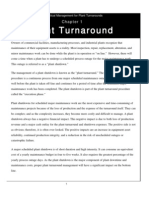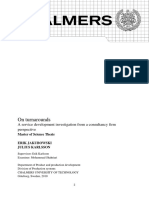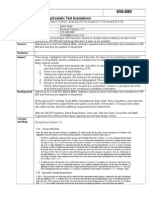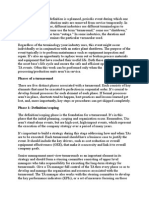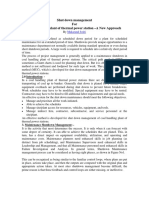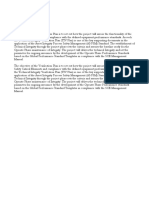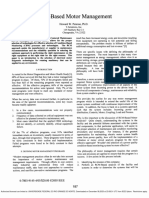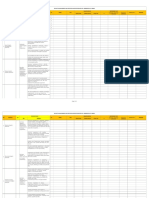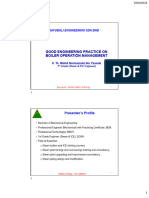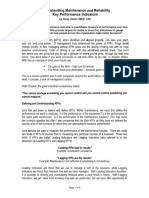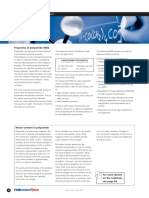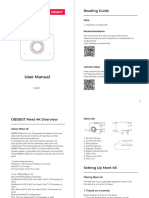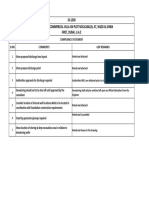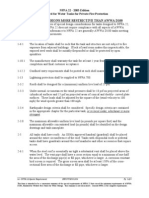SRU Turnaround Monitoring Report
Uploaded by
Allan BadilloSRU Turnaround Monitoring Report
Uploaded by
Allan BadilloMEMORANDUM February 01, 2010 To : A. B.
Monteclaro Mechanical Training Coordinator Technical Training Department cc: Report SRU Turnaround Monitoring Attached is the Training Progress Report which describes all my learning and observations from assisting a Turnaround Planner monitor the SRU Turnaround from January 8-16, 2009. The objective of this activity is to familiarize and expose a Maintenance Planner trainee to the actual duties of a Turnaround Planner. Ref. :
Code: 752 Training Progress
Prepared by: A.V. Badillo
Noted by: A.P. Uapal, Jr.
Training Progress Report SRU Turnaround Monitoring I. INTRODUCTION
The Sulfur Recovery Unit (SRU) removes hydrogen sulfide (H2S) in various refinery acid gas streams and converts it to liquid sulfur. This reduces the emmission of sulfur dioxide to the atmosphere in compliance to environmental regulations. The SRU units last scheduled turnaround was on January, 2009. But due to the need to re-install the newly retubed exchangers E3508A and E-3511, the unit was scheduled again for a turnaround this year. During the shutdown, the 20 pipeline and other auxiliary pipings of E-3508 and E-3511 was restored to its original configuration. The turnaround ran for 15 days (January 5-16, 2010). Scope of work included change out of catalysts from R-3501 reactor which was identified as the critical path activity. II. MONITORING To become familiar with the Turnaround Planners job, I was tasked to assist on monitoring the progress of the SRU turnaround. Monitoring involves determining progress of work, assessing if the schedule is being adhered to and evaluating the activities in the field. To have a better understanding of the work that has transpired in the field, information are to be solicited from the contractors supervisors and workers and other concerned departments. Related problems, if any are noted and are to be communicated to proper channels to be addressed. Safety is also a concern. Safety of all personnel and all plant equipments must always be addressed. A Planner should also ensure that all safety guidelines of the refinery is being followed. In monitoring the activities, the following are some of my observations and recommendations:
I gathered from the Turnaround book (compilation of all pertinent documents related to turnaround) that a contractor representative should report to the Senior
Planning Engineer daily at 0730H the status of their job. I, personally did not see this happening during the duration of the turnaround. If implemented, this will help the Planner a great deal in monitoring the progress of activities and in revising/adjusting his schedule if necessary. An alternative to this, Training Progress Report SRU Turnaround Monitoring 2
maybe is to provide checklists to supervisors to be accomplished as job gets completed. Especially, during large turnarounds when it will be impossible for a Planner to actually check on every activity. This will also give the actual time duration of each specific activity which will be very helpful in future turnarounds.
Inspection was carried out as planned and resulted to additional works like D-3512 Opening and cleaning and HIC-35408 pull-out and overhaul. These additional works did not impact the planned mechanical works completion but increased the cost of the turnaround. However, there were some discoveries that caused delay of the unit startup. Like problems with the rundown line of E-3508A. On safety, a comprehensive tagging procedure for scaffolding was implemented. However, for blinding/deblinding, it was usually lacking and ignored. Though there were incidents of debris (i.e. alumina balls, sulfur), it was immediately communicated to and acted upon by responsible departments. Working permits were issued and signed by respective supervisors/managers. For hot work, fire extinguishers were present near the work area. Some of the workers, though were not wearing proper personal protective equipment like safety glasses which is required to be worn at all times in refinery work area. Minor injuries were treated on site and did not result to any time loss. There was an issue about the contractor not having H2S detectors but it after reprimanding them they immediately complied. There was also an incident during the alumina balls loading wherein the catalyst drums became entangled due to miscalculated lifting by the crane operator which caused alumina balls scattering at site. The incident was reported and was immediately acted upon. No personnel were injured during the incident.
On tools and equipment, hand tool availability was good, with no work interruptions due to hand tool shortages. Tool locations proved to be effective, minimizing the distance needed to walk to get the necessary tools. Crane access to all work areas was good, as the unit is well laid out so that work area density does not become a problem. Materials were available as needed. I was not aware of any delays or problems about material requisition or any shortages. 3
Training Progress Report SRU Turnaround Monitoring
I noticed that as bolts were being removed from manways, workers just let them lying around the work area. I think that buckets should be provided to the field to place all bolts as they are being removed to prevent accidents. All welds were 100% x-rayed and tested. The amount of rework was probably in the 20% range, mostly due to lack of penetration. This, I think is to be expected due to the type of welding and other conditions prevailing in the unit. Joints were also stress-relieved to reduce internal stress and to prevent material cracking and distortion. I also think that the contractors staffing in this turnaround was adequate. The workforce was scheduled for two (2) twelve-hour shifts, seven (7) days a week. I think though, that a ten-hour shift would have been better since it will allow for an orderly change of shifts and give supervisors time for meetings and work turnovers.
III.
TURNAROUND SUBCOMMITTEE MEETING Every morning, throughout the duration of the turnaround, at 1000H the turnaround committee meets to discuss the turnaround activities. This is what they call the Turnaround Subcommittee (TASC) meeting. As per the turnaround book it should have been limited to one (1) hour to increase productivity but due to numerous matters to discuss it usually runs for two (2) hours. The following are what usually discussed in a TASC meeting:
Safety concerns Progress of work. This should have been defined in terms of percentage of work accomplished. Related problems in any activity, if theres any. Materials, tools and equipment requirements if any Latest inspection reports/recommendation Concerns of different departments (i.e. Maintenance, Operations, Inspection, Technology, etc.) Other important matters that may be raised-up
You might also like
- Turnaround Management For The Oil, Gas, and Process IndustriesNo ratings yetTurnaround Management For The Oil, Gas, and Process Industries17 pages
- Case Study - Sabic Shutdown Optimisation PDFNo ratings yetCase Study - Sabic Shutdown Optimisation PDF8 pages
- SMC Plant Turnaround 2018 General Scope PDFNo ratings yetSMC Plant Turnaround 2018 General Scope PDF36 pages
- Planning For Shutdowns, Turnarounds and Outages: Developed by Joel Levitt and The Life Cycle InstituteNo ratings yetPlanning For Shutdowns, Turnarounds and Outages: Developed by Joel Levitt and The Life Cycle Institute12 pages
- Slides - Turnaround Planning and Execution100% (1)Slides - Turnaround Planning and Execution45 pages
- TA - RP07 Turnaround and Project Integration100% (1)TA - RP07 Turnaround and Project Integration18 pages
- Service Specification For Mechanical Work in Turnarounds100% (1)Service Specification For Mechanical Work in Turnarounds25 pages
- #5.4 TURNAROUND AREA QA Manual - SAMPLE ONLY100% (2)#5.4 TURNAROUND AREA QA Manual - SAMPLE ONLY30 pages
- Turnover Activities Flow Leading To RFSUNo ratings yetTurnover Activities Flow Leading To RFSU1 page
- Scheduling Practices For Turnarounds-Shutdowns100% (1)Scheduling Practices For Turnarounds-Shutdowns118 pages
- Position Paper Management of Temporary Repairs FINAL 1100% (1)Position Paper Management of Temporary Repairs FINAL 125 pages
- Sydney, NSW - Australia, March 8-9, 2010: E-Mail: Phone: +6053687732 Mobile: +60125012590100% (1)Sydney, NSW - Australia, March 8-9, 2010: E-Mail: Phone: +6053687732 Mobile: +6012501259019 pages
- SHELL - Aging, Overworked, Debottlenecked Refineries An Increased Risk To The Insurance IndustryNo ratings yetSHELL - Aging, Overworked, Debottlenecked Refineries An Increased Risk To The Insurance Industry33 pages
- 2011 Summit Fixed Equipment Inspection Programs - r60% (1)2011 Summit Fixed Equipment Inspection Programs - r634 pages
- BP On-Repair-Strategies-Flipbook-Pdf - CompressNo ratings yetBP On-Repair-Strategies-Flipbook-Pdf - Compress35 pages
- Inspecting Distillation Towers Part 1 - Turnarounds - AIChE100% (2)Inspecting Distillation Towers Part 1 - Turnarounds - AIChE34 pages
- Meridium RBI-580 Inspection Strategies - Q12016100% (1)Meridium RBI-580 Inspection Strategies - Q12016161 pages
- Managing Corrosion Challenges Associated With Heat Exchangers100% (1)Managing Corrosion Challenges Associated With Heat Exchangers53 pages
- Good Engineering Practice - Boiler Operation Management (PRINT OUT)No ratings yetGood Engineering Practice - Boiler Operation Management (PRINT OUT)30 pages
- API STD 617 Interview Questions and Answers: The Guide for Compressor and Pump EngineersFrom EverandAPI STD 617 Interview Questions and Answers: The Guide for Compressor and Pump EngineersNo ratings yet
- Technical Information: Properties of Polyamide PA66No ratings yetTechnical Information: Properties of Polyamide PA6610 pages
- Quinn s Post Anzac Gallipoli Peter Stanley - Read the ebook online or download it as you preferNo ratings yetQuinn s Post Anzac Gallipoli Peter Stanley - Read the ebook online or download it as you prefer80 pages
- Stability Analysis and Modelling Underground Excavations in Fractured Rocks - Vol 1No ratings yetStability Analysis and Modelling Underground Excavations in Fractured Rocks - Vol 1309 pages
- Leigh Creek - Your Local Drinking Water ReportNo ratings yetLeigh Creek - Your Local Drinking Water Report3 pages
- Method Statement: Demolition of Taplow Paper Mill Job No: Taplow/01 Date: Prepared by Michael Kehoe Mide MicontmNo ratings yetMethod Statement: Demolition of Taplow Paper Mill Job No: Taplow/01 Date: Prepared by Michael Kehoe Mide Micontm40 pages
- [Mutants_and_Masterminds]The_Super_Villain_Handbook_Deluxe_Edition_Conversion_Pack100% (1)[Mutants_and_Masterminds]The_Super_Villain_Handbook_Deluxe_Edition_Conversion_Pack67 pages





